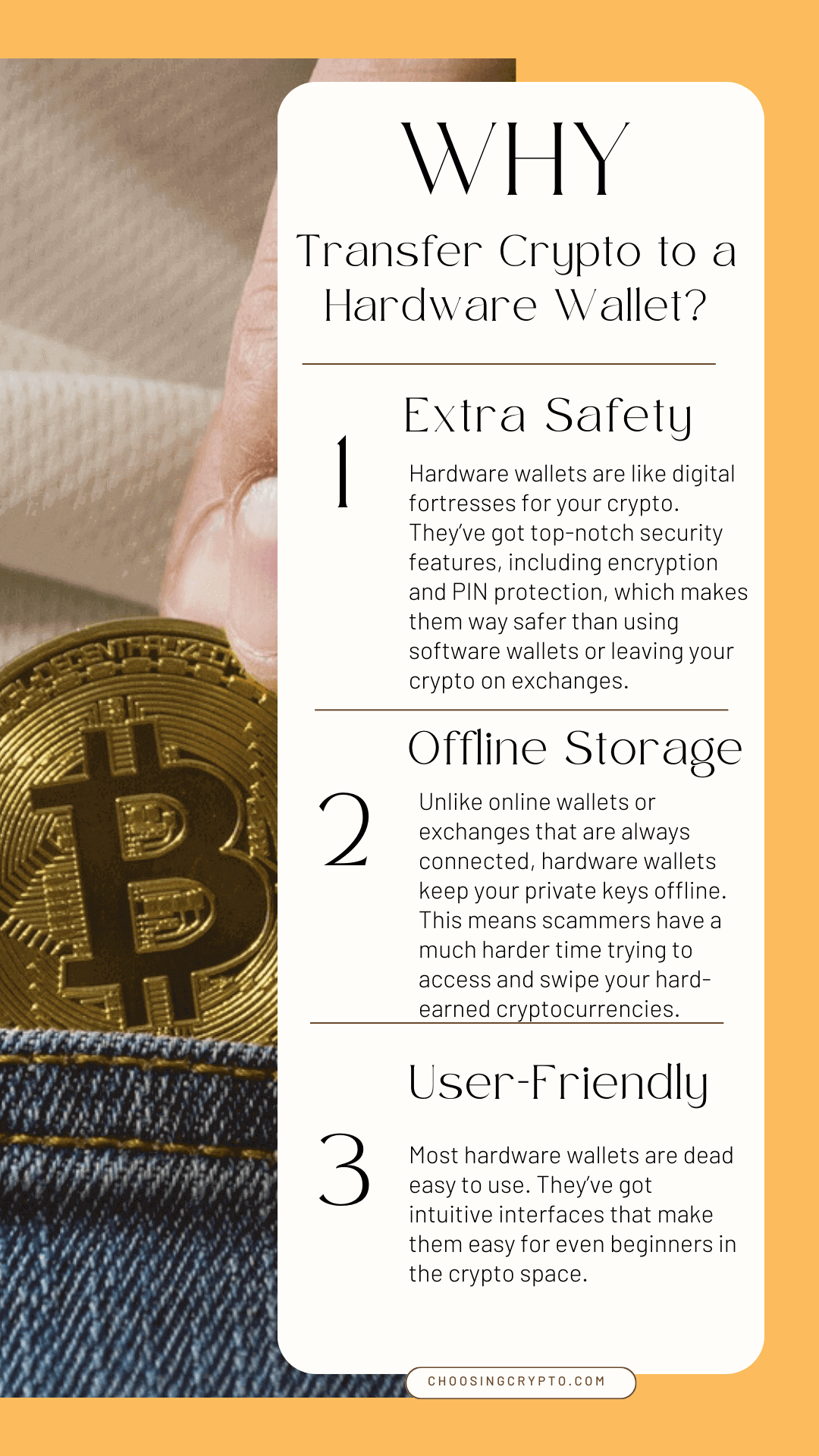Are you wondering how to transfer crypto to hardware wallet?
Well, that’s exactly what I’m going to help you with in this post – how to safely transfer your Bitcoin and other cryptocurrencies to a hardware wallet.
Here’s the deal: the cryptocurrencies you hold in your crypto exchange don’t really belong to you.
Nope, they belong to the companies running the exchange, and they’re the ones in control.
And you know what? There’s always a risk with crypto exchanges – they could get hacked or even go bankrupt. Not the ideal situation, right?
Remember this rule of thumb: if it’s not your keys, it’s not your crypto.
But what if you lose your hardware wallet? Don’t worry, I’ll cover that too, along with some other important stuff.
IMPORTANT: I've selected some really great blog posts that I think you'll absolutely love. They're waiting for you right at the bottom of this post. Don't forget to give them a read!What is a Hardware Wallet for Cryptocurrency?
A hardware wallet is a physical device, often resembling a USB stick, designed to store and manage your cryptocurrencies offline.
You might have heard of software wallets, which are online, but hardware wallets are different.
Hardware wallets ensure that your precious cryptocurrencies are kept in a secure, offline environment, away from online threats.
Why Transfer Crypto to Wallet?
Thinking about moving your crypto to a hardware wallet? Well, here’s why it’s a smart move:
- Extra Safety: Hardware wallets are like digital fortresses for your crypto. They’ve got top-notch security features, including encryption and PIN protection, which makes them way safer than using software wallets or leaving your crypto on exchanges.
- Offline Storage: Unlike online wallets or exchanges that are always connected, hardware wallets keep your private keys offline. This means scammers have a much harder time trying to access and swipe your hard-earned cryptocurrencies.
- User-Friendly: Most hardware wallets are dead easy to use. They’ve got intuitive interfaces that make them easy for even beginners in the crypto space.

How is a Hardware Wallet Different from a Software Wallet?
The difference lies in their connection to the internet.
So, a software wallet lives online, which means it could be at risk from online dangers.
But a hardware wallet stays offline, only connecting to the internet when necessary.
This keeps it really secure and gives your cryptocurrency holdings extra protection.
Read Also: Crypto Hot Wallet vs Cold Wallet
How to Transfer Crypto to Hardware Wallet
Transferring crypto to a hardware wallet is an easy thing to do. You don’t need any special knowledge.
Simply follow the steps below.
1. Buy your Hardware Wallet
First things first, buy yourself a crypto hardware wallet if you haven’t got one yet – unless you’re transferring it to someone else.
Now, if you’re transferring it to someone, skip to the next step. If not, you’ve got to make a purchase.
When you’re making a purchase, stick to the most reliable wallets out there.
Here’s a handy tip: only buy hardware wallets straight from the manufacturers who make them. That way, you can be sure it has not been tampered with.
2. Buy crypto
If you haven’t got any cryptocurrency yet, don’t worry. There are plenty of ways to get started.
Back in the day, it was a bit difficult to buy Bitcoin, but now there are loads of ways to buy cryptocurrencies.
One of the simplest methods is using crypto exchanges, which are basically platforms where you can buy and sell cryptocurrencies using your bank card or bank transfers.
If you’re wondering where to find a reliable crypto exchange, I’ve got some suggestions. Click here to check out the ones I recommend.
3. Locate Your Wallet Address
- Access Your Hardware Wallet Interface: Connect your hardware wallet to your computer and access its interface using the provided software or application.
- Go to Receive: Look for the “Receive” or “Receive Funds” section within your hardware wallet interface. Here, you’ll find your unique wallet address, which acts as the destination for your crypto assets.
- Copy the Wallet Address: Click on the option to copy your wallet address. Ensure that you’ve copied it correctly to avoid any errors during the transfer process.
4. Transfer Crypto to the Address from the Hardware Wallet
- Access Your Exchange Account: Log in to your crypto exchange account where your funds are currently stored.
- Go to Withdraw or Send: Look for the option to withdraw or send funds from your exchange account. This may be labeled differently depending on the exchange platform you’re using.
- Enter the Wallet Address: Paste the wallet address copied from your hardware wallet into the designated recipient address field on the exchange platform.
- Specify the Amount: Enter the amount of cryptocurrency you wish to transfer to your hardware wallet. Double-check the amount to ensure accuracy.
5. Confirm the Transfer
- Review Transaction Details: Take a moment to review all transaction details, including the recipient’s address and the amount being transferred.
- Verify Fees: Some exchanges may charge withdrawal fees for transferring cryptocurrencies. Make sure you’re aware of any associated fees before confirming the transaction.
- Authenticate the Transfer: Depending on the exchange platform, you may need to complete an additional authentication step, such as entering a verification code sent to your email or mobile device.
6. Verify the Transaction on Your Hardware Wallet
- Wait for Confirmation: Once you’ve initiated the transfer, wait for the transaction to be processed by the blockchain network. This typically involves waiting for a certain number of confirmations, depending on the cryptocurrency network.
- Check Your Hardware Wallet: Keep an eye on your hardware wallet interface for incoming transactions. You should see the transferred funds reflected in your wallet balance once the transaction is confirmed.
A quick tip: Before sending all your crypto, try sending a small amount first. Only send the rest once you see that small test amount safely appearing on your hardware wallet. This way, you can double-check that everything is working smoothly before making the bigger move.
Read Also: 5 Best Crypto Mobile Wallets
What Happens if you Lose your Crypto Hardware Wallet?
Many people hesitate to get a hardware wallet because they worry about losing it.
But here’s the thing: you needn’t stress about that too much because you can get back all your cryptocurrencies if you have your secret recovery phrase.
Here’s the deal: write down that recovery phrase and keep it somewhere safe.
With your recovery phrase (which some call a seed phrase), all you need to do is buy yourself a new hardware wallet, and voilà! You can recover everything from your old one.
It’s so powerful that if someone gets hold of your recovery phrase, they can swipe all your cryptocurrencies.
So, make sure you keep that recovery phrase well away from prying eyes.
Additional Resources:
Excited to learn more about Bitcoin and cryptocurrencies? We’ve got some awesome resources below to help you out.
- How to Create a Bitcoin Paper Wallet
- 7 Best Practices for Crypto Wallet Security
- How to Backup Your Crypto Wallet
- What is The Difference Between A Crypto Wallet and Exchange
- How to Secure Your Crypto From Being Stolen
- Difference Between Centralized and Decentralized Crypto Exchange
- How to Start Crypto Trading as a Beginner
- Safest Stablecoins to Use
And guess what? We’re also on Instagram and Twitter(X). Join us there for even more fun and useful content!

DISCLAIMER:
The information provided here is intended for informational purposes only and should not be solely relied upon for making investment decisions. It does not constitute financial, tax, legal, or accounting advice. Additionally, I strongly recommend that you only invest in cryptocurrency an amount you are comfortable with potentially losing temporarily.
Read Also: Understanding Crypto Wallet
